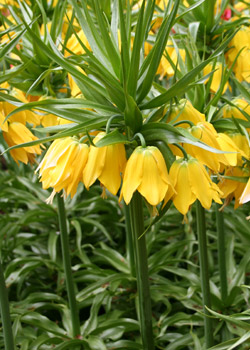Fritillaria Bulbs Information

Truly unique and somewhat quirky, fritillaria bulbs produce fabulous flowers in a variety of vibrant colors. Fritillaria are shunned by deer and rodents and some claim it even helps to keep them away from surrounding plants! The bulb tends to be quite large and often has a hollow center where the stem from the previous year had grown. The bulb itself is somewhat fragile and should be handled with care when planting.
Plant Information
- Planting Time: Fall
- Bloom Time: Mid Spring
- Hardiness Zone: 3-7
- Suitable Zone: 3-9
- Light Needs: Partial - Full Sun
Planting Fritillaria
- Fritillaria are typically planted in fall. Their roots will form in fall and they will bloom in mid-spring. It is critical to choose a planting location that has well drained soil and receives full to partial sun.
- The spacing will vary depending on the size and type of fritillaria bulb. For instance, the small bulbs of the Checkered Lily only require a spacing of 2-4". However, the large bulbs of the Crown Imperials should be planted with 8-12" of space between bulbs.
- The planting depth of the bulb will also vary depending on its size. The smaller bulbs should be planted approx. 2" deep while the larger ones should be buried 5-6" below the soil surface.
- The bulbs of the large (Crown Imperial) Red, Orange, and Yellow Fritillaria often have a hollow center where the previous year's stem grew. Because of this hollow center, it is best to plant these bulbs with this hollow area slightly tipped from the top to prevent water from sitting in this depression and causing rot.
- Thoroughly soak the area with water once all the bulbs have been planted. Water as needed while the plant is growing and blooming.
- After the flowers have died, remove the flower stem at the base. Allow the remaining foliage to yellow and die back. The leaves will continue to gather sunlight and make food for next year's blooms.
- Once the foliage has yellowed and dried, it may be removed by gently pulling it out of the soil. If the leaves do not easily pull away from the bulb, they are not ready to be removed. Once they are removed, your fritillaria will be dormant and ready to "rest" until next year!